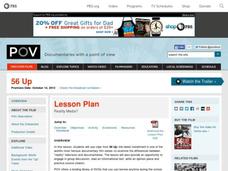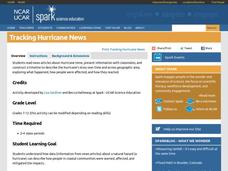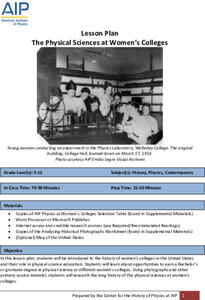Sharp School
The Jungle Project: Creating a Magazine
To conclude a study of Upton Sinclair's The Jungle, groups create a multi-media magazine in which they investigate one aspect of the foods industry. The packet details the requirements for the project, and includes rubrics for...
Sharp School
Horror Fiction Multimedia Project
"There comes an end to all things" and ending a study of horror fiction with a multimedia project is "like starting a stone. . . away the stone goes, starting others. . ." In this case, groups start with a question generated by Dr....
The New York Times
Crossing the Line Online: Sexual Harassment and Violence in the Age of Social Media - NYTimes.com
Sexual harassment and sexual violence are by no means new issues. What has changed is the role of social media in these issues. This powerful and troubling lesson uses a specific rape case to launch research into a discussion of the...
Clark County School District
Hollywood's Take on the Cuban Missile Crisis: Thirteen Days
Watching the film Thirteen Days is an engaging way of acquainting learners with the Cuban missile crisis, and this worksheet is the perfect accompaniment for viewership! It includes 15 questions for your young historians to...
Curated OER
Reality Media?
Yeah, but is it real? Clips from the famous documentary film series 56 UP launches an examination of the differences between reality television and documentaries. After considering the characteristics of each format, class members...
Center Science Education
Tracking Hurricane News
Here is a unique twist for your lesson on hurricanes. After examining extreme weather news headlines, your storm chasers view a PowerPoint about hurricanes and then zoom in on Hurricane Irene. They map a timeline of her trek up the East...
The New York Times
Stress Less: Understanding How Your Mind and Body Respond to Anxiety
What could be more relevant to teens and preteens than experiencing stress? Use an article from the New York Times website to practice valuable Common Core skills for informational text reading, and also get a discussion going in your...
Biology Junction
Photosynthesis
Why do leaves change color in autumn? A presentation and worksheet walk through many details of photosynthesis. They explain where photosynthesis occurs, why plants are green, the changing colors in autumn, energy usage, and CAM plants.
Biology Junction
Cell Reproduction
Cycles exist throughout nature, and the cell cycle compares to a life cycle of any other living being. A worksheet and presentation discuss the concepts of cell reproduction through the cell cycle. They cover each phase individually and...
Biology Junction
Hemophilia: Genetics of the F8C Gene
Queen Victoria, of England, carried the hemophilia gene, and her children passed it on to the ruling families of Russia, Spain, and Germany. Scholars learn how hemophilia passes from generation to generation—usually undetected in women....
Biology Junction
Bioenergetics
Bioenergetics strives to describe how living things gain and transform energy for biological purposes. First, pupils learn about the types of energy before exploring the importance of energy in biological processes. Next, they discover...
Biology Junction
Mutations
Are you a mutant? Learn about multiple types of mutations with a presentation to discover the answer. Both genes and chromosomes mutate at various points in their life cycles. Slides describe each type and the resulting impact on...
Biology Junction
Mendelian Genetics
Over the course of seven years, Gregor Mendel grew more than 28,000 pea plants. The large amount of data he collected led him to postulate the rules of genetics as we understand them today. Scholars learn about Mendel, genetics, and...
Common Sense Media
My Online Code
Approach ethical online behavior with a series of activities geared toward teaching pupils about digital citizenship. After a brief discussion about ethics, small groups inspect a fictional social networking profile with ethics in mind....
American Institute of Physics
The Physical Sciences at Women's Colleges
After a brief introduction to the history of women's colleges in the United States and a discussion of the resistance such institutions faced, young scientists investigate seven traditionally women's colleges and their physics programs....
American Institute of Physics
The Physical Sciences at Historically Black Colleges and Universities
The history of science instruction at Historically Black Colleges and Universities (HBCUs) is the focus of a lesson that explores the early challenges these institutions faced in accessing equipment for their labs and instructors for...
American Institute of Physics
Historical Detective: Edward Alexander Bouchet and the Washington-Du Bois Debate over African-American Education
Young scientists meet Edward Alexander Bouchet who, in 1876, was the first African American to receive a PhD in Physics. This two-part lesson first looks at the debate between Booker T. Washington and W.E.B. Du Bois about the type of...
American Institute of Physics
African Americans and Life in a Secret City
Imagine the lure of being offered a job at a secret site, working on a secret project, and earning higher wages! Such was the approach used to recruit African Americans to Hanford, Washington, one of several sites used to develop...
American Institute of Physics
African Americans in Astronomy and Astrophysics
A two-part lesson focuses on the contributions to the fields of astronomy and astrophysics of two African Americans: Benjamin Banneker and Dr. George Carruthers. In part one, scholars learn about Benjamin Banneker by examining his...
Flipped Math
More Probability
Multiply the amount of probability using addition. Pupils use probabilities to make predictions in problems. They find shortcuts to find probabilities instead of listing the entire sample space. The learners then use the multiplication...
Flipped Math
Secants and Tangents
Put the vertex in, put the vertex out. Pupils explore theorems about the relationships of lengths of segments and angles of line segments that intersect inside or outside the circle. Learners use the theorems to solve problems involving...
Flipped Math
Intercepted Arcs
Intercept the class's learning on circles. Pupils learn the relationship between intercepted arcs and inscribed angles. The scholars use that information to find the relationship of angles in an inscribed quadrilateral and an angle...
Flipped Math
Chords and Arcs
Congruence breeds congruence. Pupils learn three more circle theorems dealing with congruent chords and arcs. Learners use the theorems to find the measures of chords and arcs in circles by applying previously learned concepts in the...
Flipped Math
Tangents to Circles
Touch a circle once. Individuals watch a video and learn two theorems related to tangents and circles. The pupils then apply the theorems to find missing angle measures and lengths in figures. At the end, they practice their skills on...

























